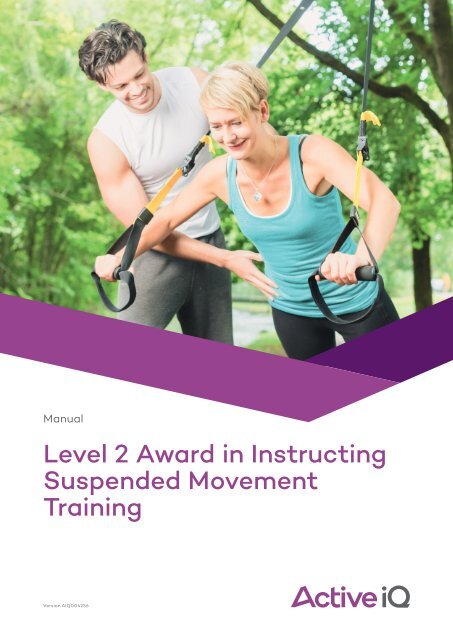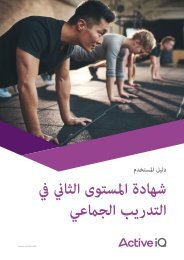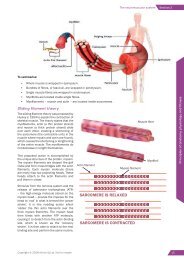Active IQ Level 2 Award in Instructing Suspended Movement Training (sample manual)
For more information, please visit http://www.activeiq.co.uk/qualifications/level-2/active-iq-level-2-award-in-instructing-suspended-movement-training
For more information, please visit http://www.activeiq.co.uk/qualifications/level-2/active-iq-level-2-award-in-instructing-suspended-movement-training
Create successful ePaper yourself
Turn your PDF publications into a flip-book with our unique Google optimized e-Paper software.
Manual<br />
<strong>Level</strong> 2 <strong>Award</strong> <strong>in</strong> Instruct<strong>in</strong>g<br />
<strong>Suspended</strong> <strong>Movement</strong><br />
Tra<strong>in</strong><strong>in</strong>g<br />
Version A<strong>IQ</strong>004256
Section 2: History of suspended movement tra<strong>in</strong><strong>in</strong>g<br />
<strong>Suspended</strong> physical tra<strong>in</strong><strong>in</strong>g has its orig<strong>in</strong>s <strong>in</strong> a number of places <strong>in</strong>clud<strong>in</strong>g the ancient Incan empire, German<br />
gymnastics and <strong>in</strong> modern times, the US Navy Seals. Whilst it is primarily the military tra<strong>in</strong><strong>in</strong>g orig<strong>in</strong> that has<br />
given rise to the grow<strong>in</strong>g <strong>in</strong>terest with<strong>in</strong> the fitness <strong>in</strong>dustry today, it is still <strong>in</strong>terest<strong>in</strong>g to be aware of the earlier<br />
history associated with this beneficial tra<strong>in</strong><strong>in</strong>g method.<br />
Inca<br />
The earliest references to physical tra<strong>in</strong><strong>in</strong>g us<strong>in</strong>g<br />
ropes to aid <strong>in</strong> condition<strong>in</strong>g and performance can<br />
be found with<strong>in</strong> the ancient Incan civilisation that<br />
dom<strong>in</strong>ated the region between the 15th and 16th<br />
centuries. The Incan empire at its peak covered a<br />
vast expanse of land across the west coast of what<br />
is now South America. This empire was divided <strong>in</strong>to<br />
4 regions with its capital at Cuzco, located <strong>in</strong> the<br />
south of what is now Peru. The most powerful figure<br />
or k<strong>in</strong>g of the empire was known as the ‘Sapa Inca’<br />
and resided <strong>in</strong> Cuzco. An important part of govern<strong>in</strong>g<br />
such a vast empire was to ma<strong>in</strong>ta<strong>in</strong> communications<br />
across the 4 regions <strong>in</strong> a quick and effective manner.<br />
The Incas set up a system that accomplished this<br />
very effectively. They built up and exploited the<br />
talents of exceptional athletes they referred to as the<br />
‘Chasqui’ or speed messengers. The young boys that<br />
were selected for lifelong service with<strong>in</strong> the empire’s<br />
communications network were required to be able<br />
to run fast, have great all round athletic ability and<br />
strong lung function to cope with the rocky terra<strong>in</strong><br />
and very high altitudes that were to be covered. The<br />
routes and roads that were cut through the Andes<br />
were dotted with relay stations where one Chasqui<br />
would pass the message onto another rested Chasqui<br />
who would cont<strong>in</strong>ue as fast as possible to the next<br />
relay station some 6-9 kilometres away. The speed and physical capabilities or the Chasqui comb<strong>in</strong>ed with<br />
the <strong>in</strong>genious relay system enabled a vital message to be carried as far as 246 miles <strong>in</strong> a s<strong>in</strong>gle day. Historical<br />
reports <strong>in</strong>dicate that the Chasqui messenger system enabled the delivery of a message from Quito (northern<br />
Ecuador) to Cuzco (southern Peru), a distance of 1230 miles, <strong>in</strong> only 5 days.<br />
The technologically advanced Roman Empire, who were renowned for their speed of communication, are<br />
noted to have considered a distance of 100 miles <strong>in</strong> a s<strong>in</strong>gle day a very good achievement. The Incan Chasqui<br />
system was by far superior. The system was so effective that the Spanish cont<strong>in</strong>ued us<strong>in</strong>g the Chasqui long<br />
after their occupation of the region. The nature of the steep terra<strong>in</strong> over the Andes mounta<strong>in</strong> range and great<br />
distances that were covered meant structured tra<strong>in</strong><strong>in</strong>g was an essential part of the physical condition<strong>in</strong>g that<br />
these men had to go through to be part of this team of elite athletes. This <strong>in</strong>cluded a strategic form of rope<br />
tra<strong>in</strong><strong>in</strong>g, devised to complement the needs of this man-powered communication network. The Chasqui were<br />
often required to navigate steep slopes and very difficult, mounta<strong>in</strong>ous terra<strong>in</strong> where ropes would assist them<br />
as they weaved their way through the tropical jungle conditions.<br />
Copyright © 2016 <strong>Active</strong> <strong>IQ</strong> Ltd. Not for resale | 5
Lower centre of<br />
gravity- relatively<br />
shorter moment arm<br />
Higher centre of gravityrelatively<br />
longer moment arm<br />
Leverage and mechanical advantage<br />
A basic appreciation of the three types of levers and how they can vary the mechanical advantage will help <strong>in</strong><br />
understand<strong>in</strong>g the forces that a client will experience when perform<strong>in</strong>g different types of suspended movement<br />
tra<strong>in</strong><strong>in</strong>g exercises. The three lever types are named simply by the position of the load or resistance <strong>in</strong> relation<br />
to the po<strong>in</strong>t where effort is applied, and the position of the pivot po<strong>in</strong>t or fulcrum.<br />
1st position 2nd position 3rd position<br />
First class Load/resistance Fulcrum/pivot Effort applied<br />
Second class Fulcrum/pivot Load/resistance Effort applied<br />
Third class Fulcrum/pivot Effort applied Load/resistance<br />
First class leverage is not a common feature of suspended movement tra<strong>in</strong><strong>in</strong>g when consider<strong>in</strong>g any exercises<br />
hold<strong>in</strong>g the handles of the straps and us<strong>in</strong>g gravity and body weight as a resistance. Second and third class<br />
leverage is much more common <strong>in</strong> this situation. The follow<strong>in</strong>g diagrams show basic press<strong>in</strong>g and pull<strong>in</strong>g<br />
exercises and how the leverage varies. This change of leverage also changes the mechanical advantage<br />
towards either greater effort or greater speed. By understand<strong>in</strong>g the mechanical advantage exercises can be<br />
planned that can either exploit this or purposefully work aga<strong>in</strong>st it.<br />
When the resistance arm is shorter than the effort arm (2nd class lever) this provides a mechanical advantage<br />
that magnifies the effort mak<strong>in</strong>g the load experienced by the user much lighter. When the resistance arm is<br />
longer than the effort arm (3rd class lever) this creates a mechanical advantage that magnifies the velocity of<br />
movement, but <strong>in</strong> so do<strong>in</strong>g makes the load experienced by the user feel heavier.<br />
2 nd class levermechanically<br />
<strong>in</strong><br />
favour of effort<br />
3 rd class levermechanically<br />
<strong>in</strong><br />
favour of velocity<br />
Load<br />
Po<strong>in</strong>t of effort<br />
Fulcrum<br />
Fulcrum<br />
Load<br />
Resistance arm<br />
Effort arm<br />
Resistance arm<br />
Effort arm<br />
Copyright © 2016 <strong>Active</strong> <strong>IQ</strong> Ltd. Not for resale | 9
Section 6: Programme design for suspended movement<br />
tra<strong>in</strong><strong>in</strong>g<br />
The exercises conta<strong>in</strong>ed with<strong>in</strong> this programme are <strong>in</strong>tended to provide a foundation on which to build your<br />
knowledge of suspended movement tra<strong>in</strong><strong>in</strong>g. They will naturally lead and progress from one exercise to the<br />
next provid<strong>in</strong>g a foundation of fitness and technical ability to perform the proceed<strong>in</strong>g exercise. There is also<br />
guidance on some of the more complex exercises and how to perform similar alternative exercise movements.<br />
The exercises are built <strong>in</strong>to a functional tra<strong>in</strong><strong>in</strong>g system of progressive or regressive exercises based on various<br />
movement patterns, body part focus, and the level of complexity. The chosen movement/body patterns are<br />
l<strong>in</strong>ked to the most common types of suspended movement tra<strong>in</strong><strong>in</strong>g exercises. These patterns are:<br />
• push<br />
• pull<br />
• squat<br />
• lunge/s<strong>in</strong>gle leg<br />
• core<br />
Many of the exercises will <strong>in</strong>volve movement <strong>in</strong> all three planes, sagittal, frontal and transverse. When used<br />
effectively these movement/body patterns, comb<strong>in</strong>ed with the planes of motion, allow the tra<strong>in</strong>er to target the<br />
functional components of human movement <strong>in</strong> a logical and ordered manner.<br />
Frontal Sagittal Transverse<br />
12 | Copyright © 2016 <strong>Active</strong> <strong>IQ</strong> Ltd. Not for resale
Advanced Programme Design<br />
When creat<strong>in</strong>g more advanced tra<strong>in</strong><strong>in</strong>g programmes there are many options available to the fitness professional,<br />
<strong>in</strong>clud<strong>in</strong>g:<br />
• design<strong>in</strong>g split rout<strong>in</strong>es<br />
• progress<strong>in</strong>g the tra<strong>in</strong><strong>in</strong>g phase<br />
• manipulat<strong>in</strong>g work to rest ratios<br />
• us<strong>in</strong>g supersets and giant sets<br />
• follow<strong>in</strong>g a circuit format<br />
• comb<strong>in</strong><strong>in</strong>g with other tra<strong>in</strong><strong>in</strong>g mediums e.g. kettlebell or dumbbells<br />
• <strong>in</strong>creas<strong>in</strong>g the movement complexity<br />
Suspension equipment is also light and versatile enough to be used <strong>in</strong> outdoor sett<strong>in</strong>gs such as tra<strong>in</strong><strong>in</strong>g <strong>in</strong> the<br />
park or as part of boot camp type tra<strong>in</strong><strong>in</strong>g. This allows for variety and provides additional appeal for suspended<br />
movement tra<strong>in</strong><strong>in</strong>g equipment.<br />
Example rout<strong>in</strong>e for an advanced client<br />
WARM UP<br />
Exercise Speed <strong>Level</strong> Duration Notes<br />
CV: Rower 28-35 spm Drag 4-6 5 m<strong>in</strong>s Gradual <strong>in</strong>crease <strong>in</strong><br />
<strong>in</strong>tensity<br />
Flexibility: all over body dynamic stretches of 12-15 reps each<br />
MAIN SESSION<br />
Exercise <strong>Movement</strong> pattern Sets x reps Rest Notes<br />
Chest Press wide<br />
to narrow<br />
<strong>Suspended</strong> Row<br />
wide to narrow<br />
<strong>Suspended</strong> press<br />
up with shoulder<br />
walk<br />
Push 3 x 10-12 60-90 sec Each Perform as a<br />
Complex Set<br />
Pull 3 x 10-12 60-90 sec<br />
Push 2 x 10-12 45-60 sec<br />
Jump<strong>in</strong>g Squat Squat 3 x 10-12 60-90 sec Perform as a<br />
Frontal lung<strong>in</strong>g ice 1 leg/lunge 3 x 10-12 60-90 sec superset<br />
skater<br />
Plank Cycl<strong>in</strong>g Core 3 x 10-12 60-90 sec Perform as a<br />
Sup<strong>in</strong>e Plank Core 3 x 10-12 60-90 sec superset<br />
Cycl<strong>in</strong>g<br />
COOL DOWN<br />
Exercise Speed <strong>Level</strong> Duration Notes<br />
Jog-walk 12-6 kph Run to Walk 5 m<strong>in</strong>s Gradual reduction<br />
<strong>in</strong> <strong>in</strong>tensity<br />
Flexibility: Full stretch<strong>in</strong>g rout<strong>in</strong>e to target key muscles utilised with<strong>in</strong> the session<br />
Copyright © 2016 <strong>Active</strong> <strong>IQ</strong> Ltd. Not for resale | 15
PUSH<br />
Straps<br />
Position<strong>in</strong>g<br />
Technique<br />
Exercise: Chest Flye<br />
Straps anchored high and set at equal length on each strap from mid<br />
to short<br />
Standard handles attached<br />
Feet neutral and fixed beh<strong>in</strong>d the body slightly anterior to the strap<br />
anchor po<strong>in</strong>t<br />
Grip handles with arms anterior at shoulder height<br />
• Lean <strong>in</strong>to the straps so that arms take the load<br />
• Move the arms outwards <strong>in</strong> horizontal extension until the hands<br />
are almost <strong>in</strong> l<strong>in</strong>e with the body<br />
• Chest and body lowered <strong>in</strong>to the flye position keep<strong>in</strong>g the sp<strong>in</strong>e<br />
and other jo<strong>in</strong>ts kept <strong>in</strong> good alignment<br />
• Drive the arms forward <strong>in</strong> front of the chest mov<strong>in</strong>g the shoulders<br />
through horizontal flexion <strong>in</strong> a typical ‘flye’ action<br />
Variations Regressive Progressive<br />
Use a split stance<br />
Vary the arm movements both<br />
higher and lower<br />
20 | Copyright © 2016 <strong>Active</strong> <strong>IQ</strong> Ltd. Not for resale
PUSH<br />
Straps<br />
Position<strong>in</strong>g<br />
Technique<br />
Exercise: <strong>Suspended</strong> dips<br />
Straps anchored high and set at equal length on each strap from mid<br />
to long<br />
Standard handles attached<br />
Straps hang<strong>in</strong>g directly downward with body immediately between<br />
straps<br />
Grip handles beside each hip and lower body until suspended with<br />
body upright and legs out <strong>in</strong> front with feet on floor<br />
• Lower the body downward by flex<strong>in</strong>g the elbows and extend<strong>in</strong>g<br />
the shoulders<br />
• Keep the chest lifted throughout<br />
• Drive upward lock<strong>in</strong>g the arms out at the top of each repetition<br />
• Ensure the legs and lower body rema<strong>in</strong> relaxed and serve as a<br />
dead weight<br />
Variations Regressive Progressive<br />
Bend the knees slightly with feet<br />
on the floor to take some load<br />
Lift one leg off the ground<br />
Copyright © 2016 <strong>Active</strong> <strong>IQ</strong> Ltd. Not for resale | 23

















